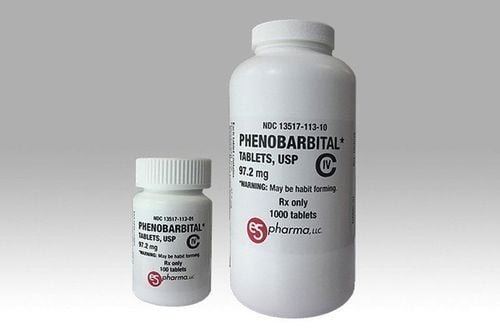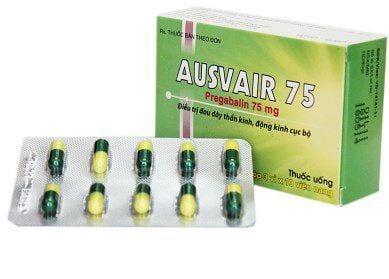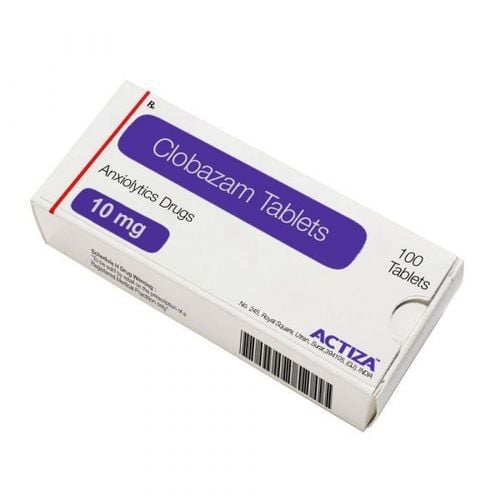This is an automatically translated article.
Sodium Valproate is an active ingredient known for its effective anticonvulsant effect. This active ingredient is found in many different commercial products, one of which is Valparin 200. So what does Valparin 200 do and how should patients use it?
1. What is Valparin 200?
Valparin 200 is a product of Torrent Pharmaceuticals Ltd (India), prepared in the form of enteric coated tablets with the packaging specification of a box of 10 blisters, each blister of 10 tablets.
Ingredients in Valparin 200:
Main active ingredient: Sodium valproate 200mg; Some excipients such as Dibasic calcium phosphate (Anhydrous), Hydroxypropylmethyl cellulose (2910 E15LV), Magnesium Stearate, Talc, Colloidal silicon dioxide, Sodium starch glycolate, Diethyl phthalate, EudragitL-30 D-55, Lake of sunset yellow.
2. Pharmacological characteristics Valparin 200
Sodium Valproate in Valparin 200 is an antiepileptic active ingredient with a mechanism of action mainly on the central nervous system.
Valparin 200 can treat epilepsy by 2 mechanisms:
The effect is directly related to the concentration of Valproate in the blood plasma and in the brain; Acts indirectly through metabolites of valproate in the brain, by acting on neurotransmitter mediators or directly acting on cell membranes. The most accepted use of Valparin 200 hypothesis involves the neurotransmitter GABA (gamma-aminobutyric acid). Accordingly, when using Valparin 200, it leads to an increase in the ratio of GABA, so it has the effect of reducing the intermediate stages of sleep along with an increase in slow sleep.
Pharmacokinetics of Valparin 200:
Bioavailability of Valparin 200 is nearly 100% after oral administration; After being absorbed Valparin 200 will be distributed mainly in blood and extracellular fluid; The half-life of Valparin 200 is about 15 - 17 hours, the major route of elimination is in the urine after metabolism in the liver through the phenomenon of conjugated glucurono and beta-oxidation; The minimum serum concentration of Sodium Valproate to achieve therapeutic effect is about 40-100 mg/ml; The degree of plasma protein binding of Valparin 200 is dose and saturation dependent; Valparin 200 does not induce enzymes in the cytochrome P450 metabolic system.
3. What are the effects of Valparin 200?
Valparin 200 is indicated for the treatment of various convulsive conditions such as:
absence seizures; Convulsions in children; Muscle twitching; Generalized tonic-clonic seizures; Intractable epilepsy; High fever convulsion.
4. Instructions for using Valparin 200
Valparin 200mg is prepared in the form of enteric coated tablets, so when using it, the patient should follow the following instructions:
The patient needs to swallow the Valparin 200 tablet whole with a glass of cooled boiled water; Never crush or chew the tablet; Do not use stimulants, alcohol, beer during treatment with Valparin 200; Valparin 200 products can be taken before or after meals. Dosage of Valparin 200 depends on the age and weight of the patient, specifically as follows:
Adults: It is recommended to start with a dose of 600mg/day (3 Valparin 200 tablets), then depending on the response. The dose can be increased every 200mg (1 Valparin 200 tablet) for 3 days, up to a maximum of 1000-2000mg/day (equivalent to 20-30mg/kg body weight/day) to achieve a therapeutic effect. desire. In some cases where the therapeutic effect cannot be achieved, the dose of Valparin can be increased from 200 to 50 mg/kg/day of body weight; Children weighing more than 20kg: The recommended starting dose is 400mg/day, equivalent to 2 Valparin 200 tablets (note that the starting dose is independent of weight). Maintenance dose of Valparin 200 20-30 mg/kg body weight/day, if not completely controlled, the dose of Valproate can be increased to 35 mg/kg body weight/day. Valparin 200 Overdose and Management:
Cases of accidental or intentional Valparin 200 overdose have been reported. Valproate plasma concentrations 5-6 times higher than therapeutic concentrations are unlikely to cause any serious symptoms, except for nausea, vomiting and dizziness; In case of large overdose, when the plasma concentration of Valparin 200 is 10 to 20 times higher than the therapeutic concentration, it will lead to severe CNS depression and may lead to respiratory depression. However, symptoms of overdosage with Valparin 200 are variable, and seizures have even been reported at very high plasma concentrations; The most serious side effect of Valparin 200 overdose is death, which has been reported with very high doses; Symptoms of Valproate toxicity are usually fully reversible with appropriate treatment, including induction of vomiting, gastric lavage, ventilatory support, and some other supportive treatment.
5. Contraindications of Valparin 200
Valparin 200 is not indicated for patients with liver failure, acute or chronic hepatitis; Persons with a personal or family history of severe liver dysfunction, especially in relation to drug use; Epilepsy patients who are pregnant should not use Valparin 200; In addition, people with Porphyrin metabolism disorders or hypersensitivity to Sodium Valproate or excipients should not use Valparin 200.
6. Some notes when using Valparin 200
Valparin 200 can cause severe liver failure:
Severe liver failure leading to death has occurred in some patients taking the active ingredient Valproate. This usually occurs during the first 6 months of taking the drug; Severe liver failure and death due to Valparin 200 can be predicted in advance through a number of non-specific manifestations such as loss of consciousness control, difficulty sleeping, facial edema, anorexia, vomiting; Patients should be checked for liver function before treatment and periodically during the use of Valparin 200, especially during the first 6 months. At the same time, doctors need to monitor carefully when appointing Valparin 200 for cases with a history of liver disease; Patients who need to be treated with multiple anticonvulsants, are children, or have congenital metabolic disorders or severe cognitive disorders with intellectual disability and encephalopathy. right this situation; Experience shows that the risk of severe progressive liver damage may be increased when Valparin 200 is prescribed to children under 2 years of age; The potential benefits of Valparin 200 for the treatment of epilepsy should be compared with the potential risks. Note that patients must immediately discontinue use of Valparin 200 if signs of liver dysfunction are noted or suspected. Valparin 200 causes CNS depression, especially when combined with other CNS depressants, so patients being treated with this drug should be careful when driving or operating complex machinery. until you make sure you're not drowsy from the medication.
Valparin 200 may cause thrombocytopenia, inhibit phase 2 of platelet aggregation or cause abnormal clotting factors. Therefore, patients treated for seizures with Valparin 200 should be closely monitored for coagulation tests, especially before surgery.
Use of Valparin 200 during pregnancy:
According to available official and unofficial data, Valproate can cause birth defects if pregnant women take the drug during pregnancy; The frequency of neural tube defects in babies is increased if pregnant women use Valparin 200 during the first 3 months of pregnancy. Other congenital malformations such as facial defects, skull defects, placental anomalies and other organ-related malformations have also been reported during maternal use of Valparin 200. Use of Valparin 200 in lactating patients:
In humans, Valproate can be excreted in breast milk; Drug concentrations in breast milk have been reported to range from 1 to 10% of serum concentrations. Therefore, caution should be exercised when prescribing Valparin 200 to lactating women.
7. Valparin 200 . side effects
Side effects on the digestive system such as nausea, vomiting, dyspepsia... are rare when using Valparin 200; Some other unusual manifestations such as loss of pain sensation, tremor, ataxia, headache, nystagmus, diplopia, dysarthria, dizziness and loss of coordination have been related to Valparin. 200 has also been reported; Some other effects may occur such as skin rash and hair loss; Valproate rarely causes thrombocytopenia, or liver damage.
8. Drug interactions of Valparin 200
Valparin 200 may increase the effectiveness of neuroleptics, monoamine oxidase inhibitors and some other antidepressants. The enzyme induction of Valparin 200 is significantly less when compared with other anticonvulsants, and therefore has almost no effect on the effectiveness of oral contraceptives. Caution should be exercised when combining Valparin 200 with anticoagulants, such as warfarin and salicylates... Valparin 200 reduces the protein binding of warfarin, but has no clinically significant effect. The sodium valproate in Valparin 200 may affect blood levels of Phenytoin. Valparin 200 may inhibit the metabolism of Lamotrigine. In some cases, the dose of Valparin 200 may need to be adjusted when combined with other anticonvulsants. Cimetidine prolongs the half-life and reduces the clearance of Valparin 200, but the same effect does not occur with Ranitidine. The extent to which sodium valproate is absorbed may be reduced when Valparin 200 is administered with Cholestyramine. Sodium Valproate in Valparin 200 is an antiepileptic active ingredient with a primary mechanism of action on the central nervous system. To ensure the effectiveness of treatment and avoid unwanted side effects, patients need to strictly follow the instructions of the doctor, professional pharmacist.
Follow Vinmec International General Hospital website to get more health, nutrition and beauty information to protect the health of yourself and your loved ones in your family.
Please dial HOTLINE for more information or register for an appointment HERE. Download MyVinmec app to make appointments faster and to manage your bookings easily.













